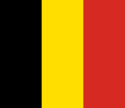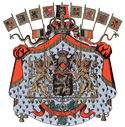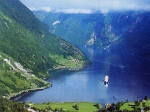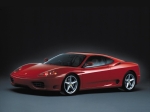
 The Kingdom of Belgium is a country in Western Europe , bordered by the Netherlands , Germany , Luxembourg , France , and the North Sea .
The Kingdom of Belgium is a country in Western Europe , bordered by the Netherlands , Germany , Luxembourg , France , and the North Sea .
Belgium is at a cultural crossroad between Germanic Europe and Romance Europe. It has Dutch speakers (the Flemings ), in the north, a small number of German speakers in the east, and French speakers (the Walloons ) in the south. This cultural and linguistic diversity is reflected in its complex institutions and political history .
Politics
Belgium's political institutions are complex, but the majority of political power is organised with the two main communities: the Flemings , and their political parties; and the French-speakers, and their parties.
Since the country's federalisation there have been many governmental entities. Apart from the Federal Government there is a subdivision according to language into Communities, with the French(-speaking) Community , the Flemish Community and the German-speaking Community , and another subdivision into Regions: the Walloon Region , the Flemish Region and the Brussels-Capital Region . The Flemish Community and the Flemish Region have been joined together to form one government, see Flanders .
Behind these complex institutions, the two dominant components of the Belgian state are the Flemings and their political institutions under the Flemish government ; and the French-speakers, grouped under the French(-speaking) Community and its more fragmented institutions. Nearly all political parties in Belgium belong to one of these two communities. The exceptions are a German-speaking party and some smaller parties in Brussels. However, these only attract votes from one of the two communities in Brussels. Thus, there are no national parties active over all the Belgian territory. In short, the Belgian political landscape carefully mirrors the dual nature of Belgian society.
Thus:
- Federal government : Jurisdiction over Foreign affairs , development aid , defence / Military , police, economy, social welfare , security (including pensions, health care, social aid and employment controls), transport (including railways and air transport), energy, telecommunications, scientific research (partially), limited competencies in education and culture, as well as strict control over taxation by regional authorities; the federal government controls more than 90 percent of all taxation.
- Community governments : Language, culture and education. (e.g. Schools, Libraries, Theatre, etc.)
- Regional governments : Land and property based issues within their area (regional economy, zoning, housing, transportation, etc.), international trade.
For example, a school building in Brussels belonging to the public school system would be regulated by the regional government of Brussels. But the school as an institution would fall under the regulations of either the Flemish government, if the primary language of teaching is Dutch, or the French Community government, if the primary language is French. It is a complex, somewhat unstable and expensive, but peaceful compromise that allows distinctly different cultures to live together.
Geography
russels , Antwerp , Ghent , Charleroi , Liege and Namur are the six largest cities of Belgium, with populations above 100,000.
Belgium has an area of 30,510 km² . Belgium has three main physical regions: the coastal plain (located in the northwest), the central plateau , and the Ardennes uplands (located in the southeast).
The coastal plain consists mainly of sand dunes and polders . Polders are areas of land, close to or below sea level , that have been reclaimed from the sea from which they are protected by dikes , or, further inland, fields that have been drained by canals .
The second physical region, the central plateau, lies further inland. This is a smooth, slowly rising area which has many fertile valleys and is irrigated by many waterways . Here one can also find rougher land, including caves and small gorges .
The third physical region (called the Ardennes) is somewhat more rugged than the first two. It is a thickly forested plateau, very rocky and not very good for farming , which extends into northern France. This is where much of Belgium's wildlife can be found.
The two main rivers in Belgium are the Scheldt and the Meuse . Although generally flat, the terrain becomes increasingly hilly and forested in the southeast ( Ardennes ) region, where one can find Belgium's highest point, the Signal de Botrange at only 694 metres.
The climate is cool, temperate, and rainy ; summer temperatures average 25°C / 77°F, winters average 7.2°C / 45°F. Annual extremes (rarely attained) are -12.2°C / 10°F and 32.2°C / 90°F.
Economy
Densely populated Belgium is located at the heart of one of the world's most highly industrialised regions. One of the first countries to undergo an industrial revolution on the continent of Europe in the early 1800s , Belgium developed an excellent transportation infrastructure of ports, canals, railways , and highways to integrate its industry with that of its neighbours. One of the founding members of the European Union , Belgium strongly supports deepening the powers of the EU to integrate European economies. Belgium was one of the first countries to adopt the euro , the single European currency, in January 1999 and the Belgian franc was completely replaced by euro coins and banknotes in early 2002 .
Belgium is sometimes called "The heart of Europe". This is not only because of its geographical location, but also due to many international institutions, such as NATO and the European Union , having their headquarters in Brussels. This, in its turn, is because it has an excellent transportation system. It has a modern and toll-free road system, is connected to the European railway system, and Antwerp is the second largest European port .
The economy in Belgium greatly depends on its imports and exports. Its main imports are food products, machinery, rough diamonds , petroleum and petroleum products, chemicals, clothing and accessories, and textiles . Its main trading partners are Germany, The Netherlands, France, the United Kingdom , Italy , the United States , and Spain . Its main exports are automobiles , food and food products, iron and steel , diamonds, textiles, plastics , petroleum products, and nonferrous metals. Trade is made together with Luxembourg, because these two countries created a customs and currency union in 1922 .
Demographics, language and literacy
The population density , 336/km², is one of the highest in Europe, after the Netherlands and some smaller countries such as Monaco . The areas with the highest population density are around the Brussels-Antwerp-Ghent-Leuven agglomerations, as well as other important urban centres as Liège, Charleroi, Kortrijk, Brugge, Hasselt and Namur. The Ardennes have the lowest density.
Historically, Belgium has three ethnic communities: Flemings , Walloons and German-speakers , which belonged to Germany until 1918, and three official languages, one for each community, Dutch , French and German . About 60 percent of the country is Dutch-speaking, French is the second most-spoken language (by about 40 percent) and German is spoken by less than 1 percent of the population.
But these figures must be taken with care because the most-recent linguistic census was before 1960 , and the mother tongue is not always the same as the language used in public, or in official life. This applies especially to the many minority goups who more or less kept their ethnic identity, the oldest being the Jews , established in Antwerp since the Middle Ages, and various more recent-migrant communites as Italians , Spaniards , Poles , Turks or Moroccans . Within each of those communities, language use varies widely, with parts of each community maintaining their language of origin over generations, other parts moving towards the language of the city of residence. Percentages differ widely between the various migrant groups.
Both the Dutch spoken in Belgium and the Belgian French have small vocabulary differences from the varieties spoken in the Netherlands and France , but are mutually intelligible with their respective neighbouring dialects . Many speak Flemish or Walloon dialects which are often difficult to understand for people from other areas. Other regional languages officially recognised (in Wallonia only) are Champenois , Gaumais , and Picard .
Brussels , the capital, is mostly French-speaking, but officially French-Dutch bilingual. It evolved from a Dutch-speaking place when the Belgian state became independent in 1830 to its current dominantly French character being the capital of the central administration of the federal country that for a long time favoured French.
More than 98 percent of the adult population is literate. Education is required from the age of 6 until the age of 18, but most Belgian students keep on studying until the age of 23. This makes Belgium's education system the second most intensive in Europe, after the United Kingdom's. Nevertheless, in recent years concern is rising over certain forms of illiteracy as 'functional illiteracy'.




